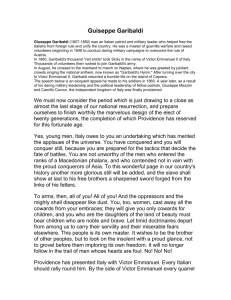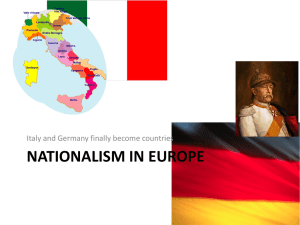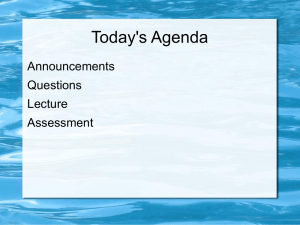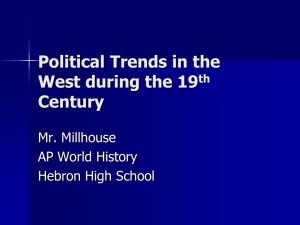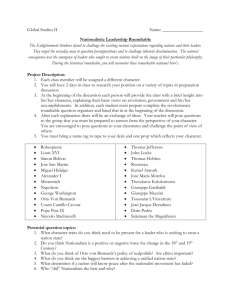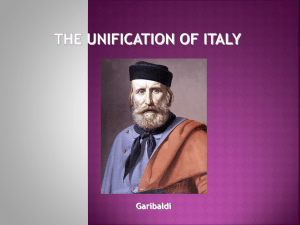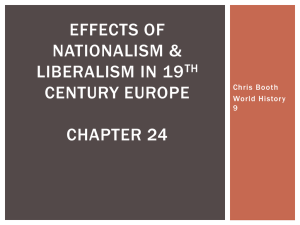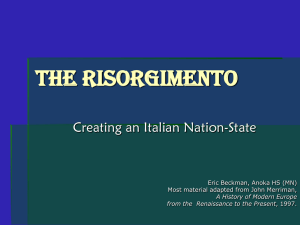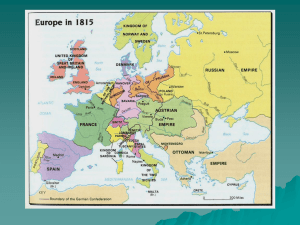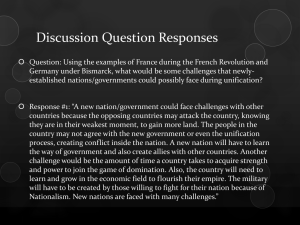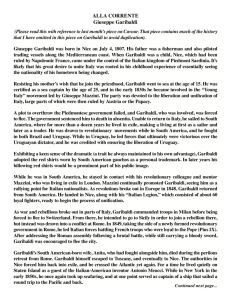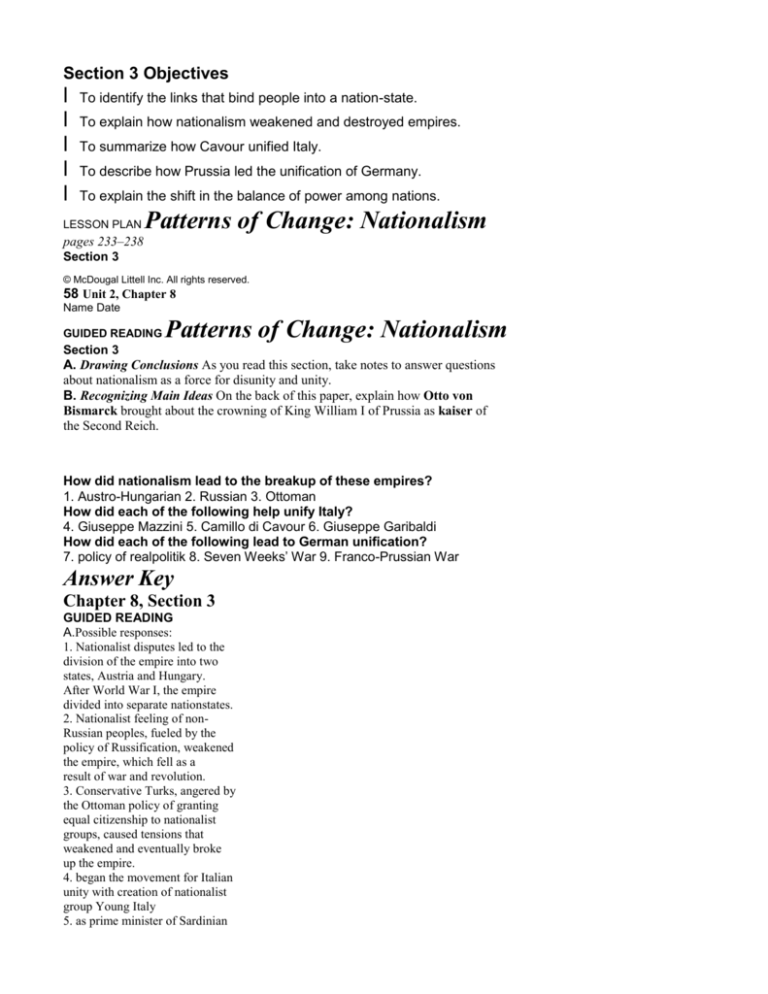
Section 3 Objectives
l1 To identify the links that bind people into a nation-state.
l2 To explain how nationalism weakened and destroyed empires.
l3 To summarize how Cavour unified Italy.
l4 To describe how Prussia led the unification of Germany.
l5 To explain the shift in the balance of power among nations.
LESSON PLAN
Patterns of Change: Nationalism
pages 233–238
Section 3
C
© McDougal Littell Inc. All rights reserved.
58 Unit 2, Chapter 8
Name Date
GUIDED READING
Patterns of Change: Nationalism
Section 3
A. Drawing Conclusions As you read this section, take notes to answer questions
about nationalism as a force for disunity and unity.
B. Recognizing Main Ideas On the back of this paper, explain how Otto von
Bismarck brought about the crowning of King William I of Prussia as kaiser of
the Second Reich.
CHAPTER
8
How did nationalism lead to the breakup of these empires?
1. Austro-Hungarian 2. Russian 3. Ottoman
How did each of the following help unify Italy?
4. Giuseppe Mazzini 5. Camillo di Cavour 6. Giuseppe Garibaldi
How did each of the following lead to German unification?
7. policy of realpolitik 8. Seven Weeks’ War 9. Franco-Prussian War
Answer Key
Chapter 8, Section 3
GUIDED READING
A.Possible responses:
1. Nationalist disputes led to the
division of the empire into two
states, Austria and Hungary.
After World War I, the empire
divided into separate nationstates.
2. Nationalist feeling of nonRussian peoples, fueled by the
policy of Russification, weakened
the empire, which fell as a
result of war and revolution.
3. Conservative Turks, angered by
the Ottoman policy of granting
equal citizenship to nationalist
groups, caused tensions that
weakened and eventually broke
up the empire.
4. began the movement for Italian
unity with creation of nationalist
group Young Italy
5. as prime minister of Sardinian
king, worked to expand
Sardinian empire; through war,
alliances, and help of nationalist
rebels, succeeded; in the
process, unified Italy
6. captured Sicily and united the
southern areas of Italy he conquered
with kingdom of
Piedmont-Sardinia
7. This policy of tough politics
allowed Bismarck to expand
Prussia and achieve dominance
over Germany.
8. Victory over Austria gave Prussia
control over northern Germany.
9. Victory over France motivated
southern Germany to accept
Prussian leadership.
B. Possible response: Through a
policy of “blood and iron,” Otto
von Bismarck eliminated Austria
as a rival, provoked war with
France, and achieved Pru s s i a n
dominance over northern and
southern Germany to create the
Second Reich, ruled by Kaiser
William I.
Nationalist Revolutions Sweep the West 103 © McDougal Littell Inc. All rights reserved.
Name Date
SECTION QUIZ
Patterns of Change: Nationalism
Section 3
A. Terms and Names Write the letter of the best answer.
______1. Which country suffered the most lost territory as a result of the unification
of Italy?
a. France
b. Russia
c. Prussia
d. Austria
______2. Rome became the capital of the Kingdom of Italy after the conquest of
a. Venetia.
b. Lombardy.
c. the Papal States.
d. Piedmont-Sardinia.
______3. Who was behind the organization of a group known as Young Italy?
a. Giuseppe Mazzini
b. Camillo di Cavour
c. Giuseppe Garibaldi
d. King Victor Emmanuel II
______4. Which of the following was the leader of the Red Shirts?
a. King William I
b. Camillo di Cavour
c. Otto von Bismarck
d. Giuseppe Garibaldi
______5. Who originated the political style known as realpolitik?
a. Giuseppe Mazzini
b. Camillo di Cavour
c. Otto von Bismarck
d. Giuseppe Garibaldi
______6. The ruler of the new, unified German empire was given the title of
a. czar.
b. reich.
c. kaiser.
d. Junker.
B. Critical Thinking Briefly answer the following question on the back of
this paper.
How influential do you think feelings of nationalism are in terms of conflicts
around the world today? Explain.
Answer Key
Chapter 8, Section 3
SECTION QUIZ
Patterns of Change: Nationalism
A.1. d
2. c
3. a
4. d
5. c
6. c
B. Students should recognize that
nationalism is still a powerful
force today and is involved in
major conflicts around the
world. Students could note such
points as the following.
a. Not many years ago, nationalism
was behind the breakup of
the Soviet Union. Nationalistic
feelings currently influence
the establishment of independent
nation-states within that
region and serious conflicts
within and between them.
b. In the Middle East,
Palestinians battle for a homeland
against Israel, itself a
nation-state that has strong
nationalistic sentiment.
c. In Northern Ireland, Catholic
revolutionaries struggle
against what they see as
British domination of what
should be their own nation.
Nationalist Revolutions Sweep the West 65 © McDougal Littell Inc. All rights reserved.
Name Date
PRIMARY SOURCE
Proclamation of 1860
by Giuseppe Garibaldi
Giuseppe Garibaldi, an Italian nationalist, issued this proclamation before he left
on a successful military expedition in May 1860 to liberate Sicily, the first step
toward unifying southern Italy. How did Garibaldi try to persuade Italians to
fight for Italy’s independence?
Section 3
T
he Sicilians are fighting against the enemies of
Italy, and for Italy. To furnish them with money
and with arms, and to bring them the aid of his
strong right arm, such is the duty of every Italian.
The spirit of discord and the indifference of any
one province to the fate of her neighbour are the
things that have been at the bottom of the misfortunes
of Italy.
The salvation of Italy began on the day on
which the sons of the same soil rushed forward to
defend their brothers when in danger.
If we abandon these brave children of Sicily and
leave them to their fate, they will have to fight
against the mercenaries of the Bourbon, plus those
of Austria and those of the priest who reigns in
Rome.
Let the people of the liberated provinces lift
high their voices in championing the cause of their
brothers who are fighting! Send your generous
youth where the battle is for the Motherland!
Let the Marches, and Umbria, and Sabina, and
the Roman Campania, and the land of Naples rise,
so as to bring division into the forces of our enemy!
If the towns do not offer sufficient support to
the insurrection, let the more determined of you
range the country in bands.
A brave man can always find arms! In the name
of God, do not listen to the cowards who parade
before their richly laden tables!
Let us arm! Let us fight for our brothers! Tomorrow,
we shall fight for ourselves.
A little band of brave men who follow me on
the country’s battlefields are marching to the rescue
along with me. Italy knows them: they appear
whenever the tocsin of danger sounds. Noble and
generous comrades! they have consecrated their
lives to their country. They will give to her their last
drop of blood, seeking no other reward save that of
having done their duty, and that a clear conscience
may abide with them.
“Italy and Victor Emmanuel!” This, our battlecry
when crossing the Ticino, will echo to the fiery
rocks of [AE]tna. To this cry, prophetic of combat,
and borne along by Italy’s lofty mountains as far as
the Tarpeian rock, the tottering throne of tyranny
will crash. All, then, will rise as one man!
To arms! At one blow, let us end the sufferings
of centuries. Let us prove to the world that it was
indeed in this land that the sturdy race of ancient
Romans once lived.
from Alexandre Dumas, ed., The Memoirs of Garibaldi
(New York: D. Appleton and Company, 1931), 359.
Discussion Questions
Recognizing Facts and Details
1. According to Garibaldi, what did the embattled
Sicilians need to fight Italy’s enemies?
2. Why did Garibaldi think Italians should volunteer
to help the Sicilians?
3. Recognizing Propaganda Propaganda is the
use of slanted information to further one’s own
cause or damage an opponent’s cause. What are
two examples of propaganda in Garibaldi’s proclamation?
CHAPTER
8
Answer Key
Chapter 8, Section 3
PRIMARY SOURCE
Proclamation of 1860
Possible responses:
1. money, arms, and volunteer soldiers
2. because it was their duty;
because indifference in the past
led to Italy’s domination by
other nations; because Sicilians
needed help to fight the armies
of Austria, the Spanish
Bourbons, and the Roman
Catholic popes; because the liberation
of Sicily was an important
step in the unification of
Italy
3. Some students may recognize
specific propaganda techniques
such as name-calling, loaded
words, and bandwagon.
Examples of propaganda include
referring to the soldiers of the
opposition as mercenaries, calling
Italy the motherland, and
calling Garibaldi’s soldiers sons
and brothers.
© McDougal Littell Inc. All rights reserved.
72 Unit 2, Chapter 8
CONNECTIONS ACROSS TIME AND CULTURES
Bonds That Create a Nation-State
As you learned in Chapter 24, nationalism led to the formation of nation-states.
In a nation-state, people are linked by such common bonds as government, culture,
and history. What common bonds do people in the United States today
share? Work with a partner to fill in the chart below. If you need help, consult an
almanac or encyclopedia.
Name Date
Section 3
CHAPTER
8
THEMATIC CONNECTION:
POWER AND AUTHORITY
Common Bonds That Link the People of the United States Today
1. Nationality:
2. Territory/Land:
3. Government:
4. Language:
5. Religion:
6. Culture:
7. Economy:
8. Other:
Answer Key
Chapter 8, Section 3
CONNECTIONS ACROSS
TIME AND CULTURES
Possible responses:
1. many countries of origin; citizenship
gained by many either by
birth or through naturalization
2. 50 states and the District of
Columbia; Puerto Rico, Guam,
U.S. Virgin Islands, and other
territories
3. representative democracy; federal
republic
4. English as primary language of
business, government, and education;
Spanish as emerging second
language; many other languages
and dialects spoken
5. various, predominantly Christian
6. shared holidays, foods, dress,
forms of entertainment, sports,
literature, public education
7. modified form of capitalism and
free enterprise system
8. currency, history, world view,
political system
CHAPTER
8
8
HAPTER

